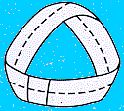Skip over navigation
Make a Magic Circle - a never-ending, one-sided shape
You will need :
A sheet of paper - A4 or A3
Coloured pencils
A pair of scissors
Sellotape or Scotch tape
What to do :
The name of this strip is a Mobius Strip or Band after the mathematician, Alfred Mobius.
Or search by topic
Number and algebra
Geometry and measure
Probability and statistics
Working mathematically
Advanced mathematics
For younger learners
Making Maths: Make a Magic Circle
Age 7 to 11
Challenge Level 





Make a Magic Circle - a never-ending, one-sided shape
You will need :
A sheet of paper - A4 or A3
Coloured pencils
A pair of scissors
Sellotape or Scotch tape
What to do :
- Cut a long, thin strip from the full length of your sheet of paper.
- Write the letters A,B,C and D as shown in the diagram.

- Draw a line right down the centre of the strip of paper, starting mid-way between A and B and ending mid-way between C and D. Or you can colour each side of the strip in a different colour.
- Twist the strip and tape the two ends together so that "A" touches "D" and "B" touches "C." Your strip should now look like this:

- If you look at the line that you drew what do you notice? If you coloured the strip, do the same colours match up,? Do you end up back where you started?
- The really interesting thing about this strip, are all the things that you can now do with it. For instance, cut your strip down the middle, as though you are cutting two, thinner strips. But do you get two?
- How many edges does the new band have? How many sides does it have? How many twists are there in the ring? What have you discovered?
The name of this strip is a Mobius Strip or Band after the mathematician, Alfred Mobius.

